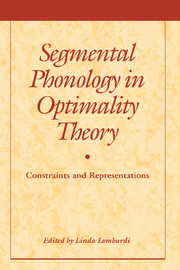Introduction
Published online by Cambridge University Press: 05 July 2014
Summary
Optimality Theory (OT) (Prince and Smolensky 1993; McCarthy and Prince 1993) has rapidly become the dominant framework in formal phonological theory. In OT fundamental notions of generative grammar are revised by replacing rules and derivations with interacting well-formedness constraints. The phonological literature immediately prior to OT had shown that such constraints were crucial to the construction of explanatory analyses. (Prince and Smolensky 1993 give nearly half a page of such references; limiting ourselves just to works on segmental phonology by authors represented in this volume, we can point to such works as Ito 1986, 1989; Lombardi 1991, 1995; Mester 1986; Yip 1988.) But incorporating such constraints into derivational theory posed a number of problems.
One problem was that it was difficult to make a formal connection between constraints and the rules that accounted for the related alternations. (See Prince and Smolensky 1993, ch. 10, for discussion of some attempts.) It has long been observed that many languages exhibit phonological conspiracies (Kisseberth 1970): that is, there are different rules that have the effect of making forms obey the same surface well-formedness constraints. And many languages have been observed to have a kind of duplication problem: the constraints needed to restrict underlying forms and the rules that give the correct surface forms have the same effects. But in derivational theory the rules and the constraints were stated separately from each other, and also stated separately on the different levels, and were not formally linked.
Information
- Type
- Chapter
- Information
- Segmental Phonology in Optimality TheoryConstraints and Representations, pp. 1 - 10Publisher: Cambridge University PressPrint publication year: 2001
